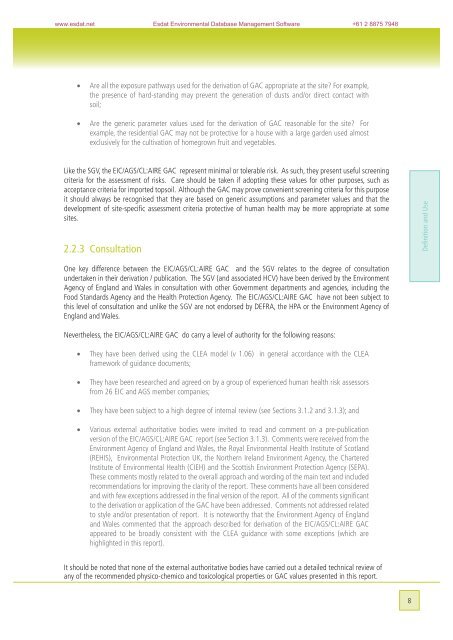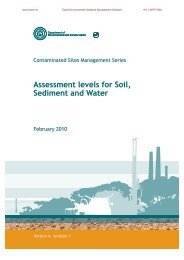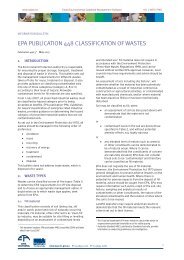Soil Generic Assessment Criteria for Human Health Risk ... - ESdat
Soil Generic Assessment Criteria for Human Health Risk ... - ESdat
Soil Generic Assessment Criteria for Human Health Risk ... - ESdat
You also want an ePaper? Increase the reach of your titles
YUMPU automatically turns print PDFs into web optimized ePapers that Google loves.
www.esdat.net Esdat Environmental Database Management Software +61 2 8875 7948<br />
• Are all the exposure pathways used <strong>for</strong> the derivation of GAC appropriate at the site For example,<br />
the presence of hard-standing may prevent the generation of dusts and/or direct contact with<br />
soil;<br />
• Are the generic parameter values used <strong>for</strong> the derivation of GAC reasonable <strong>for</strong> the site For<br />
example, the residential GAC may not be protective <strong>for</strong> a house with a large garden used almost<br />
exclusively <strong>for</strong> the cultivation of homegrown fruit and vegetables.<br />
Like the SGV, the EIC/AGS/CL:AIRE GAC represent minimal or tolerable risk. As such, they present useful screening<br />
criteria <strong>for</strong> the assessment of risks. Care should be taken if adopting these values <strong>for</strong> other purposes, such as<br />
acceptance criteria <strong>for</strong> imported topsoil. Although the GAC may prove convenient screening criteria <strong>for</strong> this purpose<br />
it should always be recognised that they are based on generic assumptions and parameter values and that the<br />
development of site-specific assessment criteria protective of human health may be more appropriate at some<br />
sites.<br />
2.2.3<br />
Consultation<br />
Definition and Use<br />
One key difference between the EIC/AGS/CL:AIRE GAC and the SGV relates to the degree of consultation<br />
undertaken in their derivation / publication. The SGV (and associated HCV) have been derived by the Environment<br />
Agency of England and Wales in consultation with other Government departments and agencies, including the<br />
Food Standards Agency and the <strong>Health</strong> Protection Agency. The EIC/AGS/CL:AIRE GAC have not been subject to<br />
this level of consultation and unlike the SGV are not endorsed by DEFRA, the HPA or the Environment Agency of<br />
England and Wales.<br />
Nevertheless, the EIC/AGS/CL:AIRE GAC do carry a level of authority <strong>for</strong> the following reasons:<br />
• They have been derived using the CLEA model (v 1.06) in general accordance with the CLEA<br />
framework of guidance documents;<br />
• They have been researched and agreed on by a group of experienced human health risk assessors<br />
from 26 EIC and AGS member companies;<br />
• They have been subject to a high degree of internal review (see Sections 3.1.2 and 3.1.3); and<br />
• Various external authoritative bodies were invited to read and comment on a pre-publication<br />
version of the EIC/AGS/CL:AIRE GAC report (see Section 3.1.3). Comments were received from the<br />
Environment Agency of England and Wales, the Royal Environmental <strong>Health</strong> Institute of Scotland<br />
(REHIS), Environmental Protection UK, the Northern Ireland Environment Agency, the Chartered<br />
Institute of Environmental <strong>Health</strong> (CIEH) and the Scottish Environment Protection Agency (SEPA).<br />
These comments mostly related to the overall approach and wording of the main text and included<br />
recommendations <strong>for</strong> improving the clarity of the report. These comments have all been considered<br />
and with few exceptions addressed in the final version of the report. All of the comments significant<br />
to the derivation or application of the GAC have been addressed. Comments not addressed related<br />
to style and/or presentation of report. It is noteworthy that the Environment Agency of England<br />
and Wales commented that the approach described <strong>for</strong> derivation of the EIC/AGS/CL:AIRE GAC<br />
appeared to be broadly consistent with the CLEA guidance with some exceptions (which are<br />
highlighted in this report).<br />
It should be noted that none of the external authoritative bodies have carried out a detailed technical review of<br />
any of the recommended physico-chemico and toxicological properties or GAC values presented in this report.<br />
8








